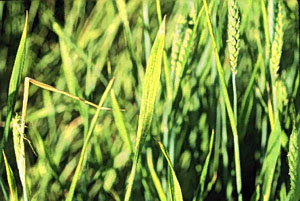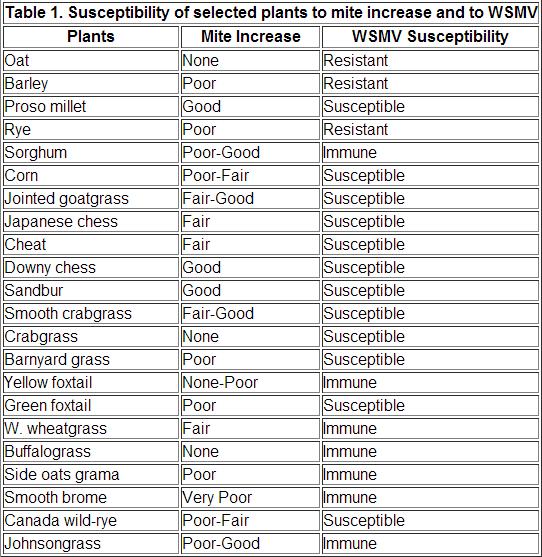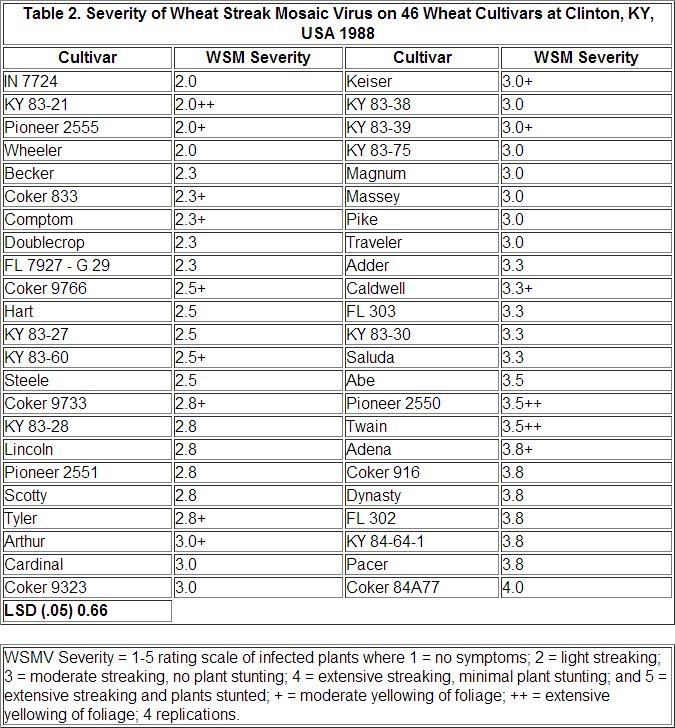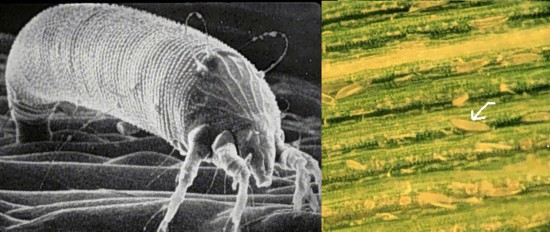Wheat Streak Mosaic Virus and the Wheat Curl Mite
ENTFACT-117: Wheat Streak Mosaic Virus and the Wheat Curl Mite | Download PDF
by Lee Townsend and Doug Johnson, Extension Entomologists
Don Hershman, Extension Plant Pathologist
University of Kentucky College of Agriculture
Introduction

WSMV
Wheat streak mosaic, a viral disease (WSMV) vectored by the wheat curl mite (Aceria tosichella Keifer), is common in the central plains of the US. The disease was first noticed in Kentucky in 1987 with widespread infections in 1988. Since then only occasional problems have been seen.
When wheat plants become infected in the fall, yield losses can be so severe that the crop is not harvested. Spring infections usually cause minimal yield losses. However, the impact varies with other plant stresses (drought, temperature, etc.), cultivar and mite/virus populations.
Disease Symptoms
Infected plants normally are stunted, and have mottled and streaked leaves. The leaf streaks are green-yellow, have parallel sides, and are discontinuous. Symptoms can vary with the cultivar, strain of the virus, time of infection, and environmental conditions.
Leaf mite-infested leaves tend to remain erect, with their lateral margins rolled toward the upper midrib.
Three other viruses that attack small grains occur in Kentucky: barley yellow dwarf virus (BYDV), wheat spindle streak mosaic virus (WSSMV), and soil-borne wheat mosaic virus (SBWMV). There are differences between plants infected with WSMV and other viruses. Leaves of plants infected with BYDV show marginal yellowing of leaves but are not streaked. Symptoms on plants infected with WSSMV or SBWMV disappear as temperatures increase in the spring. Also, WSSMV distribution is usually widespread in the field while SBWMV occurrence is often associated with soil and drainage patterns.
Diagnosis
Identification of wheat streak mosiac virus is made with the aid of an electron microscope or by an Enzyme Linked Immunosorbent Assay (ELISA) test. ELISA is a process where plant sap is extracted from the suspected virus infected plant sample and combined with virus antiserum. Reactions of the unknown sap are then compared to the reaction of sap known to be contaminated with WSMV. A similar reaction between the two samples confirms the presence of WSMV.
Host Range of Virus and Mite
Viruses multiply only in living hosts and cannot move by themselves. Some type of carrier or vector is needed for viruses to move from plant to plant. The only known carrier of WSMV is the wheat curl mite. Both the mites and WSMV persist on living, susceptible plants, but not on wheat or other grasses as they mature and dry down. Growing wheat is the favorite habitat for the wheat curl mites. Certain other small grains, such as oats, barley, and rye can be attacked by both WSMV and the mites, but they do not show obvious symptoms or significant damage. (See Table 1.)

Corn, although susceptible to both the mites and the WSMV, is not appreciably damaged by either. An exception to this statement is where maize chlorotic mottle virus (MCMV) is present. In these instances double infections of MCMV and WSMV occur, and give rise to corn lethal necrosis disease. Sorghums (including johnsongrass) are very poor hosts for wheat curl mites and are immune to WSMV.
Wheat Curl Mite
The wheat curl mite, Aceria tosichella, is a member of a group of microscopic plant-feeding pests that can affect plant vigor and growth. Leaf curl mites are about 1/100 inch long. The cigar-shaped body has small, forward-directed legs. There is a small fleshy pod at the rear end of the mite.
Wheat Curl Mite, Aceria tosichella
Mite Biology
The life stages of the wheat curl mite are: egg, two larval stages, and adult. Females lay between 3 and 25 eggs, usually about 1 per day, during their life. The minute eggs are fastened to the leaves in straight lines parallel to the leaf veins. Mite populations build most rapidly at between 75° - 80°F.; a complete cycle can be completed in 7 to 10 days. Under ideal conditions, one adult theoretically could produce 3 million offspring in 60 days. Development is very slow at 48°F and essentially stops at 32°F. All stages can survive at least 3 months at near freezing temperatures and can survive for several days at 0°F.
Wheat leaf curl mites can survive Kentucky winters but survival is best during mild winters. In fact, they can become active and reproduce during warm days in mid-winter. Reproduction slows during hot, dry weather, but some mites can survive as long as green wheat or grass is available for food. Volunteer wheat is the major source for mite build-up.
The most critical time for the mite is the period from wheat ripening until the emergence of next year's crop. Wheat curl mites must constantly be in contact with a growing wheat plant or another host. In the laboratory, these mites can survive only about 8 hours at 75°F without food or water.
All stages of the leaf curl mite can be found on cultivated and volunteer wheat and some perennial grasses during the winter months. The mites become active with the flush of new growth in the spring. Mite numbers increase on the plant and they being to move upward to the newest growth. Leaf curl mites colonize protected areas of the plant - under leaf sheaths, within the furls on new leaves, and later in the glumes of wheat heads. Feeding by the mite prevents the leaf from unrolling, so infested plants have the characteristic "leaf curl" symptom. Large numbers of mites on plants cause severe leaf rolling which causes unexpanded leaves to trap the grain head.
Mite Movement
Mites crawl very slowly and depend almost entirely on wind for movement from plant to plant. As wheat matures, it is no longer suitable as a food plant. The mites tend to move to the outer surfaces of the wheat head as it dries. They stand upright on their tail end where wind currents can carry them to a new food plant.
The spread of WSMV is related to the dispersal of the mite vector. Mites do not have wings so their movement through the air is totally dependent on wind speed and direction, thus their distribution is totally random. Temperatures of 65°F and wind speeds of 15 mph or more will cause widest spread of the individuals. While mites can be carried several miles by winds, severe infestations generally develop only within 1/4 to 1/2 mile of the source field. New infestations usually first occur along field margins and at times, these are the only areas that are affected. Mites that do not land on a suitable host plant will die.
Generally, corn is in the mid-whorl stage at the time mites are leaving wheat fields. Mites that land on corn plants will crawl into the leaf sheaths to feed and reproduce. As ears develop, the mites can move to feed on husks, silks, and kernels. Kernel feeding begins in the early milk stage. As the ears mature and dry, the mites will again take up positions on the outer plant parts to be blown away. Those that are carried to emerging wheat will remain there over winter. Some may survive if they land on another suitable food plant. Basically, mite survival depends on corn and wheat. Corn and volunteer wheat are important in maintaining significant populations of this mite between wheat crops. This sequence also is important in keeping WSMV present in an area. The mites can carry the virus from wheat to corn and back to wheat again through growing seasons.
Weather Effects
As wheat plants mature, leaf curl mites move to the last remaining green tissue, including ripening grain. When grain is shattered before harvest, for example by hail damage, mites attached to grain may survive long enough to move to the sprouting seedling. This results in keeping the mites and the virus, if present, on volunteer plants.
Hot dry weather during mid-summer can reduce mite populations and virus problems significantly, but survival of both on grasses can prevent complete elimination. Wet summer weather permits growth of volunteer wheat. The earlier curl mites can become established on it, the more there are that can be blown to wheat seeded in the fall.
Warm weather in October and November extends the period of time that mites can reproduce in the fall and increases mosaic severity. Also, warm periods occurring February and March can result in mite build up and spread, as well.
Mites as WSMV Vectors
The rod-shaped virus is taken into the mite's body as it feeds on an infected plant. The virus is carried in the mid- and hind gut of both larval and adult stages. Once inside the mite, the virus can be passed on to other plants upon which the mite feeds. The virus can be picked up during a 10 to 30 minute feeding period and remains active in the mite for 7 to 9 days. The virus remains in the mite as it molts from stage to stage, but cannot be passed to the next mite generation through the egg stage.
During the 1988 epidemic wheat streak mosaic virus was identified and evaluated in the variety trial at Clinton, Hickman County, Kentucky, USA. Samples were collected from all varieties and mechanically inoculated onto wheat seedlings in the greenhouse. All 46 cultivars tested positive, thereby confirming infection in all varieties. Qualitative levels of virus by cultivar were not measured in this test. The greenhouse test did establish that none of the 46 cultivars were immune to the virus. The severity rating of 46 cultivars to WSMV are given in Table 2.

Note: These results are from one year and one location only.
Management Recommendations
- Volunteer wheat and grasses should be destroyed at least 10 days prior to planting in the fall to limit vector survival.
- Early planting of wheat is discouraged due to increase probability of fall infection of WSMV and many other disease-causing organisms of wheat.
- Select cultivars with low severity ratings where WSMV is perceived a threat to production.
- Control grassy weeds in stubble fields, in conservation reserve acres and in set-aside acres to reduce virus and mite populations.
- The use of acaricides or insecticides against the leaf curl mite has not resulted in effective control of WSMV. Cultural practices and resistant wheat varieties are the major tools in mite and disease management.
Revised: 2/96
CAUTION! Pesticide recommendations in this publication are registered for use in Kentucky, USA ONLY! The use of some products may not be legal in your state or country. Please check with your local county agent or regulatory official before using any pesticide mentioned in this publication.
Of course, ALWAYS READ AND FOLLOW LABEL DIRECTIONS FOR SAFE USE OF ANY PESTICIDE!
Photos courtesy Lee Townsend & Ric Bessin, University of Kentucky Entomology

